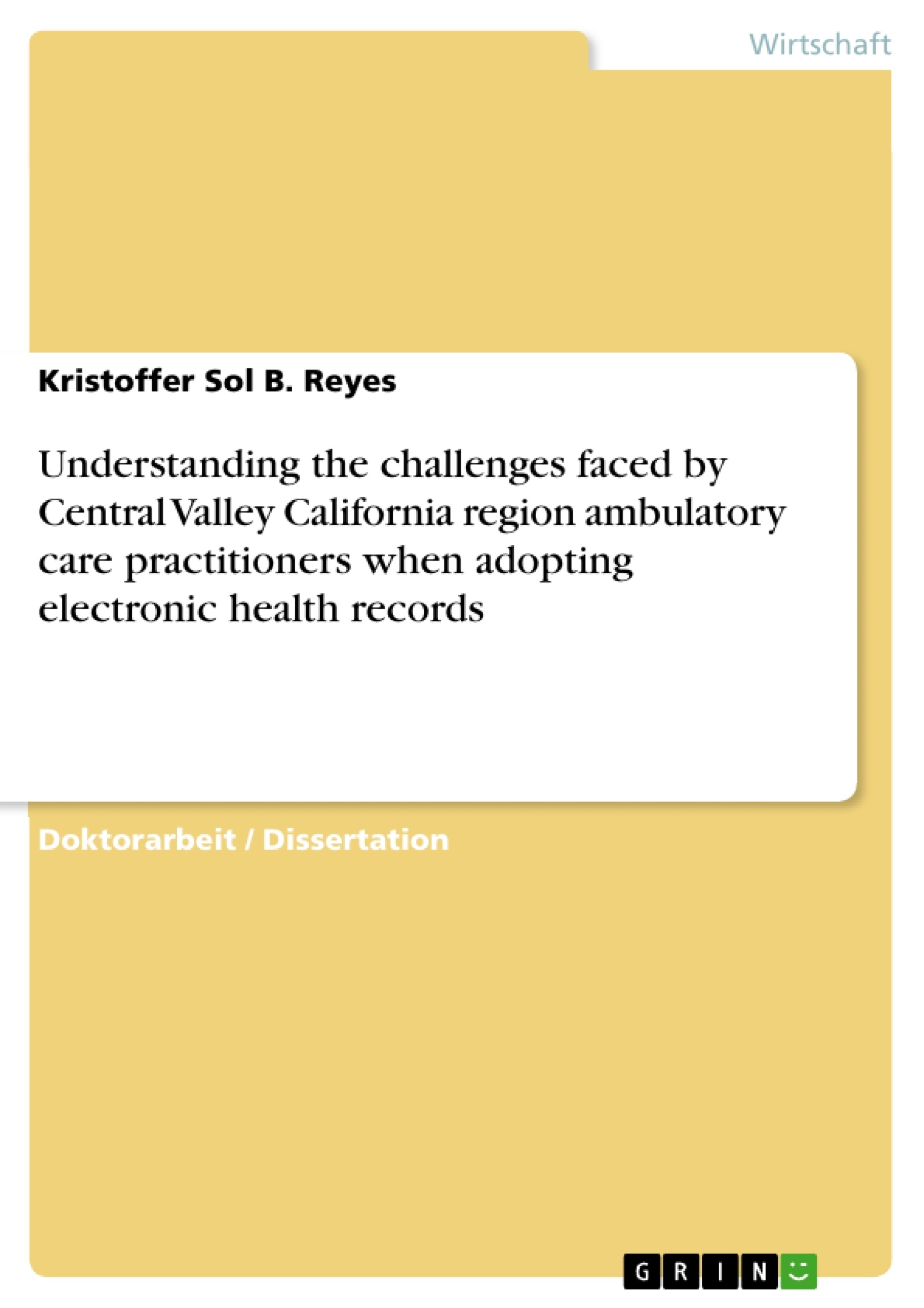Most prior research concerning electronic health record adoption was conducted in many parts of the United States, including New York, Massachusetts, California, Texas, Washington, and the country in an aggregate. However, none of the research studies was focused on the Central Valley California Region. Little attention has been paid to the challenges for ambulatory physician practices in implementing such a complex system. This is significant because these practices serve a large proportion of the population and failure to address this issue could lead to an increase in the disparity in access to healthcare. The purpose of this study was to examine the challenges faced by these small physician practices in the Central Valley California Region in implementing the electronic health record. The research question sought to understand these challenges in order to encourage implementation of the electronic health record. A qualitative, non-experimental, exploratory, single-case study was conducted using the conceptual framework of diffusion of innovation theory Data were collected by conducting interviews. Data were analyzed for commonalities and grouped into themes. Findings were eight common themes that emerged as the challenges encountered by ambulatory care practitioners in the Central Valley California Region during implementation of an electronic health record system. As more small physician practices integrate into the electronic health record system, the implications for social change are that the quality of healthcare may increase.
Inhaltsverzeichnis
- Abstract
- Dedication
- Acknowledgements
- List of Tables
- List of Figures
- Chapter 1: Introduction
- Background of the Study
- Statement of the Problem
- Purpose of the Study
- Research Questions
- Significance of the Study
- Definition of Terms
- Assumptions
- Limitations
- Delimitations
- Organization of the Study
- Chapter 2: Literature Review
- Electronic Health Records
- Diffusion of Innovation Theory
- Challenges in EHR Adoption
- Central Valley California Region
- Summary of Literature Review
- Chapter 3: Methodology
- Research Design
- Population and Sample
- Data Collection Procedures
- Data Analysis Procedures
- Ethical Considerations
- Chapter 4: Findings
- Theme 1: Cost
- Theme 2: Training and Support
- Theme 3: Workflow and Process Changes
- Theme 4: Interoperability
- Theme 5: Security and Privacy
- Theme 6: Technology Infrastructure
- Theme 7: Patient Engagement
- Theme 8: Lack of Awareness and Knowledge
- Chapter 5: Discussion
- Summary of Findings
- Implications for Practice
- Implications for Research
- Limitations of the Study
- Recommendations for Future Research
- Chapter 6: Conclusion
- References
- Appendix A: Interview Protocol
- Appendix B: Informed Consent Form
Zielsetzung und Themenschwerpunkte
Diese Dissertation befasst sich mit den Herausforderungen, denen sich ambulante Versorgungseinrichtungen im Central Valley Kaliforniens bei der Einführung elektronischer Gesundheitsakten (EHR) stellen. Die Studie zielt darauf ab, diese Herausforderungen zu verstehen und so die Implementierung von EHR zu fördern. Die Studie verwendet die Diffusion of Innovation Theory als konzeptionellen Rahmen, um die Herausforderungen zu untersuchen, die von kleinen Arztpraxen in der Region Central Valley Kalifornien bei der Implementierung von EHR-Systemen erlebt werden.
- Herausforderungen bei der Einführung von EHR in kleinen Arztpraxen
- Einfluss von Kosten auf die EHR-Adoption
- Die Rolle von Schulung und Support bei der erfolgreichen Implementierung von EHR
- Herausforderungen im Zusammenhang mit der Interoperabilität von EHR-Systemen
- Datenschutz und Datensicherheit im Kontext von EHR
Zusammenfassung der Kapitel
Kapitel 1 führt in das Thema der Dissertation ein und stellt den Hintergrund, die Problemstellung, den Zweck, die Forschungsfragen, die Bedeutung, die Definitionen, die Annahmen, die Einschränkungen, die Abgrenzungen und die Organisation der Studie dar.
Kapitel 2 bietet einen umfassenden Überblick über die einschlägige Literatur zu elektronischen Gesundheitsakten, der Diffusion of Innovation Theory, den Herausforderungen bei der EHR-Adoption, der Region Central Valley Kalifornien und fasst die Literaturrecherche zusammen.
Kapitel 3 beschreibt die Methodik der Studie, einschließlich des Forschungsdesigns, der Population und Stichprobe, der Datenerhebungsverfahren, der Datenanalysemethoden und der ethischen Erwägungen.
Kapitel 4 präsentiert die Ergebnisse der Studie, die in acht Themenbereiche unterteilt sind: Kosten, Schulung und Support, Workflow und Prozessänderungen, Interoperabilität, Sicherheit und Datenschutz, Technologieinfrastruktur, Patientenengagement und mangelndes Bewusstsein und Wissen.
Kapitel 5 diskutiert die Ergebnisse der Studie, einschließlich der Implikationen für die Praxis, die Implikationen für die Forschung, die Einschränkungen der Studie und Empfehlungen für zukünftige Forschung.
Schlüsselwörter
Die Schlüsselwörter und Schwerpunktthemen des Textes umfassen elektronische Gesundheitsakten (EHR), die Diffusion of Innovation Theory, Herausforderungen bei der EHR-Adoption, ambulante Versorgungseinrichtungen, Central Valley Kalifornien, Kosten, Schulung und Support, Workflow und Prozessänderungen, Interoperabilität, Sicherheit und Datenschutz, Technologieinfrastruktur, Patientenengagement und mangelndes Bewusstsein und Wissen.
- Citar trabajo
- Kristoffer Sol B. Reyes (Autor), 2014, Understanding the challenges faced by Central Valley California region ambulatory care practitioners when adopting electronic health records, Múnich, GRIN Verlag, https://www.grin.com/document/292985



